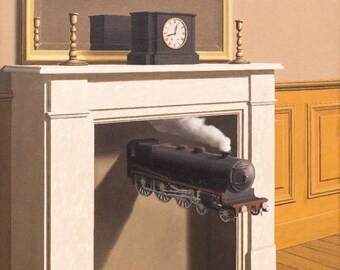Rene Magritte Casino Knokke
René Magritte was born on the 21st November, 1898 in Hainaut, Belgium. His father was a tailor and a merchant. As his business did not go well the family had to move often. René lost his mother early and tragically – she committed suicide for unclear reasons. René was only 14 years old at the time.

From 1916 through 1918 Magritte studied in the Royal Academy of Arts in Brussels (Académie Royale des Beaux-Arts). He became a wallpaper designer and commercial artist. His early painting works were executed under the influence of the Cubism and Futurism (1918-20), then he was inspired by the Purists and Fernand Léger. In 1922 Magritte married Georgette Berger, with whom he first became acquainted when fifteen years old. After meeting again in 1920, she became his model and then wife.
The acquaintance with Giorgio de Chirico'sPittura Metafisica (Metaphysical Painting) and Dadaistic poetry constituted an important artistic turning-point for Magritte. In 1925 he came close with a group of Dadaists and co-operated in the magazines Aesophage and Marie, together with E.L.T. Mesens, Jean Arp, Francis Picabia, Schwitters, Tzara and Man Ray.
In 1926 Magritte painted The Lost Jockey, it is his first painting that he allowed to be labeled as 'Surrealist'. After his first, badly-received, one-man show in Brussels in 1927, he left for Paris. In 1927-30 Magritte lived in France, where he participated in the activities of the Surrealists, establishing a close friendship in particular with Max Ernst, Dali, André Breton and especially with Paul Eluard.
Between 1951 and 1953, he paints an immense fresco the casino of Knokke-le-Zoute. The rest of its life consists of Belgian and international exhibitions Magritte died in Brussels on August 15th 1967 at 69-year-old, having painted more than 1000 paintings, as well as gouaches and collages. Charly Herscovici took one look at the installation of Rene Magritte. The Mellens had commissioned Magritte in 1952 to paint a mural at their casino in the smart Belgian seaside resort of Knokke.
In Paris, Magritte's system of conceptual painting was formed, it remained almost unchanged until the end of his life. His painting manner, intentionally dry and academic, 'polished in the technical sense' (p.18 Magritte. By Marcel Paquet. Taschen. 1992) with precise and clean draughtsmanship demonstrated a paradoxical ability to depict trustworthy an unreal, unthinkable reality.
In Magritte’s works the morphologically similar objects belonging to different classes, exchange some qualities or unite as hybrids (Companions of Fear. 1942, The Explanation, 1954, The Flavour of Tears, 1948); a night landscape gleams under daylit skies (The Empire of Lights 1954).
Demonstrating the problems of visual perception and illusionary of images, Magritte used the symbols of mirrors, eyes, windows, stages and curtains and pictures within pictures (The False Mirror, 1935, The Key to the Fields. 1936, Beautiful World. 1962.)

Rene Magritte Casino Knokke De
Magritte was fond of philosophy and literature. Many of his paintings reflect his impressions of literature works, illusions and philosophical metaphors, e.g. The Giantess (after Baudelair) 1929-30; The Domain of Arnheim (after Edgar Poe) 1938; Hegel's Holiday. 1958 (homage to Hegel's dialectics).
Casino Knokke Restaurant
In the 1940s Magritte made two attempts to change his painting style. But the so-called “vie-heureuse” or “plein-soleil” period of 1945-47, when he painted in the style of Renoir, and the “époque vache” (Cow Period) that followed in 1947-48 did not prove to be effective and the artist returned to his previous manner.
In the 1950s Magritte executed two fresco cycles: The Enchanted Realm for a casino in Knokke-le-Zut (1953) and The Ignorant Fairy (1957) for the Palais des Beaux-Arts in Charleroi. These monumental compositions repeat the motifs of his previous paintings. In his last year Magritte began to make sculptures of his painted images, developing the theme of correlation of mental and material realities.
Rene Magritte Casino Knokke De
Magritte died of cancer at the age of 69, August 15, 1967 in Brussels.